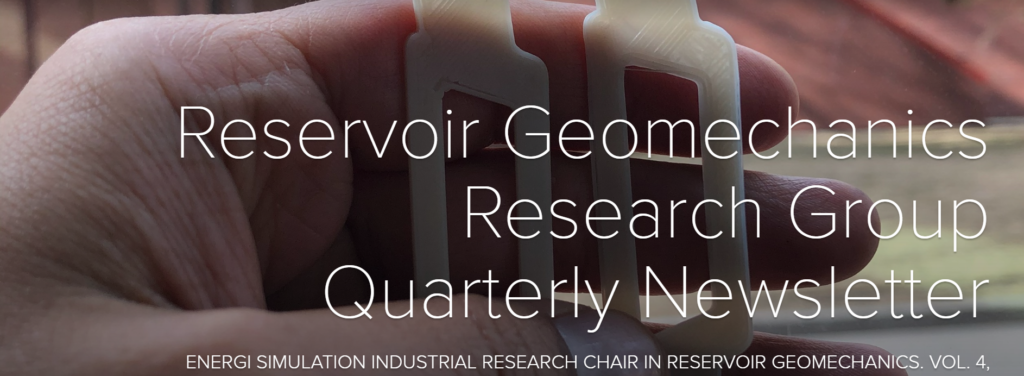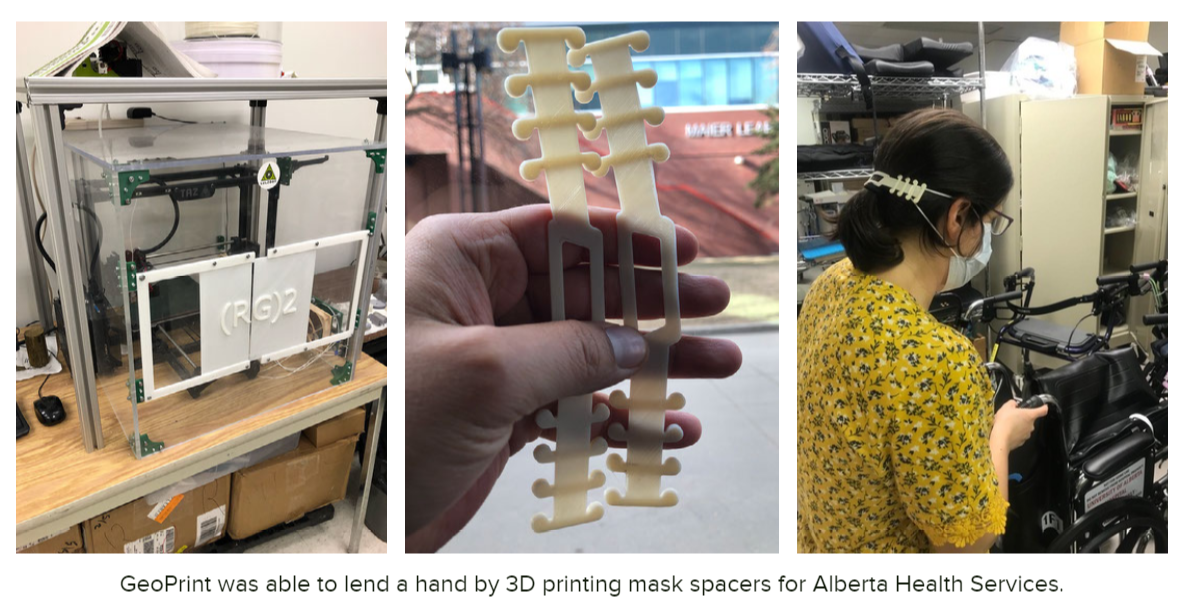
July 20, 2020
Welcome to a double issue of the [RG]2 Quarterly Newsletter, covering January through June 2020. From within CoVID-19 lockdown, our team has continued their exemplary research working both from home and in the lab, and we are excited to share with you what we have been up to. We hope you enjoy!
RESEARCH UPDATES
On behalf of our sponsors, we are very pleased to announce the launching of the NSERC/Energi Simulation Industrial Research Consortium on Reservoir Geomechanics from 2019 to 2025.
The establishment of the NSERC/Energi Simulation Industrial Research Consortium on Reservoir Geomechanics will benefit industry through the continued development of a highly skilled research centre focused on their needs and the training of highly qualified personnel to fill key technical positions and transfer technology directly into these organizations. Our research projects are embedded within five fully integrated themes and are motivated by the growing recognition that assumptions of uniformity at certain scales are inadequate for extrapolating fluid behavior, both temporally and spatially, and are exploring how geomechanical processes influence this multi-scale fluid behavior. Our research outcomes are focused on informing the increasingly complex inter-relationships between reservoir engineering and geomechanical engineering, from pore to reservoir to field scale and remain targeted at the challenges associated with the sustainable development of shale/tight oil & gas resources and the challenges linked to in situ thermal recovery processes in oil sands.
In addition to the invaluable contributions from our industry sponsors, this consortium is supported by an NSERC Industrial Research Chair in Reservoir Geomechanics awarded to Dr. Chalaturnyk, an NSERC Collaborative Research and Development award and the continued support by Energi Simulation, including their establishment of the Energi Simulation Endowment for Reservoir Geomechanics research at the University of Alberta.
The research program continues to benefit from our four unique GeoInnovation Environments; an expanded GeoREF (Geomechanical Reservoir Experimental Facility), GeoCERF (Geotechnical Centrifuge Experimental Research Facility), GeoPRINT (a facility for 3D Printing of Geological Media for Reservoir Geomechanics), and GeoRMT (Geomechanical Reservoir Modelling Technology).
The Reservoir Geomechanics Research Group is very pleased to announce that we have received funding for both the NSERC/Energi Simulation Collaborative Research and Development Consortium on Reservoir Geomechanics and the NSERC/Energy Simulation NSERC Industrial Research Chair in Reservoir Geomechanics. We have already begun recruiting new HQP to help drive this exciting new research forward, and look forward to the creative and intellectual challenges this opportunity provides.
[RG]2’s CoVID-19 Response
With classes being held online in September and research activity restrictions that will continue indefinitely on campus, we are extremely proud of the progress that our researchers are still making despite this challenging situation. Like most research groups at the University of Alberta, the majority of our staff and students continue working from home. We have only a handful of students and staff still working in our GeoInnovation Centres, and their safety has been our priority. In addition to implementing important hygiene protocols and providing additional mandatory PPE for unavoidable person-to-person contact, we have adopted a staggered work schedule to minimize interactions and maintain social distancing. After a special workshop on proper donning and doffing techniques for masks and gloves held in April, Dr. Chalaturnyk generously purchased and distributed reusable masks for member of [RG]2 and their families.

With classes being held online in September and research activity restrictions that will continue indefinitely on campus, we are extremely proud of the progress that our researchers are still making despite this challenging situation.
In the Lab
Angel Sanchez, one of our PhD students, has continued working in the lab. Natural rocks can be heterogeneous due to complex diagenetic processes that affect mineralogy and pore architecture. 3D-printing rock analogs in sand is a promising alternative for experimental testing that can be used to calibrate variables during geotechnical testing. While 3D-printed sand is a homogeneous material, the parameters for creating grain packing and pore infill can be tuned to mimic specific geomechanical and transport properties. Initially, 3D-printed specimens have a low density due to a loose distribution of grains. Efforts at increasing the density through incorporating a roller in the printing process to compact individual layers is being employed along with introduction of a more heterogeneous sand mixture that encompasses a wide range of grain-size distributions.
In the Field
In recognition of the advancements we have made in the Reservoir Geomechanical Pressuremeter (RGP) tool, the Reservoir Geomechanics Research Group is collaborating with Nagra to deploy the second generation of the RGP tool (RGP2N) in a deep borehole being drilled as part of the geoscience siting program for a nuclear waste repository in Switzerland. Nagra (National Cooperative for the Disposal of Radioactive Waste) is the Swiss technical competence centre in the field of deep geological disposal of radioactive waste. This opportunity has grown from two successful campaigns of RGP tests in the Mont Terri Underground Lab in Switzerland. The RGP2N tool will be wireline deployed at depths up to 1000m and will enable the interpretation of geomechanical constitutive parameters as well as capturing high resolution, anisotropic borehole deformation measurements to support unique inversion algorithms for computing the orientation and magnitude of in situ stresses. These tests will provide invaluable experience as we continue to move the RGP technology to its third phase to allow deployment in unconventional reservoirs to depths of 3000 m and provide unprecedented measurements of formation stiffness, pore pressure and in situ horizontal stresses.
WEBINARS
The timing couldn’t actually be any better for us to once again start up our webinars! We look forward to sending out the schedule in the coming weeks so that members of [RG]2 have an opportunity to share their research and receive vital feedback and collaboration from both their peers and Industry.
PRESENTATIONS, PUBLICATIONS, POSTERS, & PRIZES
Unfortunately, due to CoVID-19 travel restrictions resulting in most conferences being postponed or outright cancelled, [RG]2 has been adapting to presenting and participating through virtual meetings. GeoPrint is offering Short courses at the GeoConvention being held September 21-23, 2020 as well as a Short Course on October 24, 2020 and a Session on 3D printing in geoscience and engineering at the Geological Society of America annual virtual meeting on October 28, 2020.
Sliding in a trip just prior to travel restrictions, PhD Student Lang Liu was fortunate enough to present on his work using the pressuremeter at the Annual Mont Terri Meeting in Switzerland on January 30, 2020.
Dr. Chalaturnyk will be a Keynote Presenter at the 2nd International Conference on Energy Geotechnics, currently scheduled to take place in La Jolla, California, USA from September 20-23, 2020. https://icegt-2020.eng.ucsd.edu/program
Dr. Chalaturnyk is nominated by the Program Committee to be an invited speaker at the InterPore 2021 Conference taking place in Edinburg, UK, from 31 May 2021 to 3 June 2021.
Khademi M., Chalaturnyk R., (2020), Geomechanical Characterization of Inclined Heterolithic Stratification Lithosome and Its Permeability Evolution under SAGD Stress Paths, SPE Journal, Society of Petroleum Engineers, https://doi.org/10.2118/195968-PA
Talman, S., Rangriz Shokri, A., Chalaturnyk, R.J., and Nickel, E. Salt Precipitation at an Active CO2 Injection Site. Gas Injection into GeologicalFormations and Related Topics, (183–200). Ying Wu, John J. Carroll, Mingqiang Hao and Weiyao Zhu (eds.) © 2020 Scrivener Publishing LLC
Now Recruiting
With new funding comes new opportunity! [RG]2 will soon be recruiting for various positions including MSc and PhD students and Post Doctoral Fellows for programs starting in September 2020 and beyond. Please watch www.rgrg.ca for postings.
Click the link below to see the full report including a feature article by Amir H. Haghi, PhD, a special section on how we have begun implementing Equity, Diversity, and Inclusion training for all members of our group and much more!